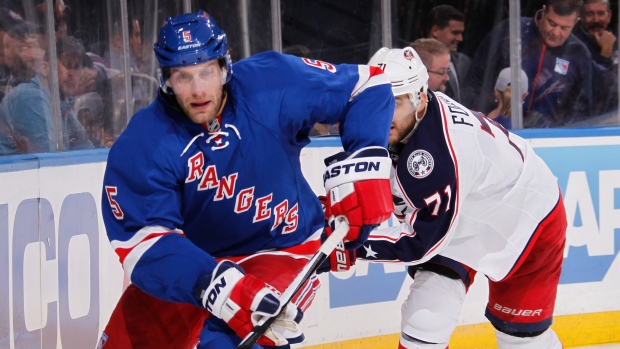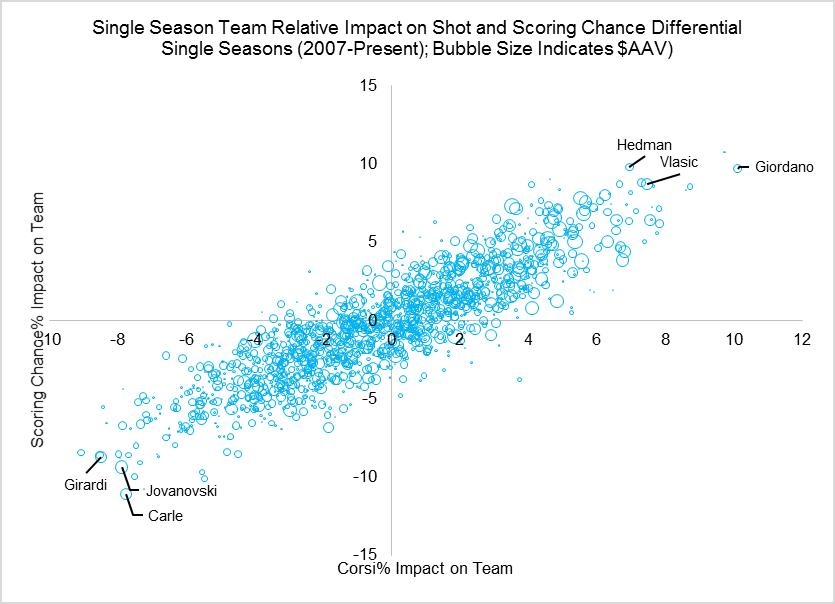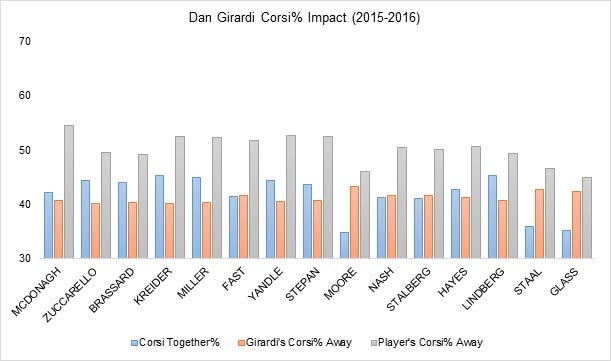Mar 24, 2016
Rangers won’t win without altering blueline
New York defenceman Dan Girardi is a clear-cut example of a miscast player from a numbers perspective, Travis Yost writes, and it’s hurting his team’s chances to win
By Travis Yost

I’m not sure if there’s been a more lopsided beatdown this season than the one the San Jose Sharks handed to the New York Rangers on Saturday night.
The 4-1 final score really didn’t do the Sharks justice.
New York goalie Henrik Lundqvist was pulled from the game in the third period despite stopping 43 of 47 (91.5 per cent) of shots. It’s impossible to believe that head coach Alain Vigneault thought his star goaltender was at fault. Sharks forwards were buzzing around the Rangers’ net for the entire game, generating swaths of scoring chances and generally owning the run of play.
More likely, Vigneault mercy pulled Lundqvist out of sheer frustration with the rest of the team. Or, to simply avoid what could’ve been a devastating goaltender injury.
The situation brewing in New York is almost indescribable. On most nights, it’s the world’s best goaltender smoothing over a colossally flawed roster that just hasn’t played very well. Their position in the standings is almost exclusively due to Lundqvist’s mere presence and the massive number of wins he’s individually added to the team.
Careful observers of the team have noted that there’s a frustrating disparity across the roster: A group of reasonably talented and capable forwards is being hamstrung by a struggling blueline.
I generally agree with this sentiment. I thought that one of the most iconic plays of the season happened in the San Jose game, when Rangers’ defender Dan Girardi was beaten soundly by Sharks’ winger Tomas Hertl.
It was not easy to watch, but it encapsulated everything that’s become evident in Girardi’s game: he no longer defends well, he bleeds scoring chances, is frequently beaten when he’s in position and can’t really recover when he’s out of position.
The numbers argument against Girardi is probably as compelling as it was in the lead up to the Dave Bolland, David Clarkson, and Andrew MacDonald contracts. That is to say, there’s not a lot of evidence – outside of his placement on a raw pay scale – that the player can add a lot of value to the team.
I do wonder how much of Girardi’s contract (he’s signed through the 2019-20 season at an AAV of $5.5-million) is obfuscating what should be a very easy decision for the team. It’s not easy to sit one of your highest-paid players, but there’s no doubt that Girardi’s earned it at this point.
Consider the kind of impact he’s had on the Rangers this year as it pertains to their shot and scoring chance differentials. It’s one of the worst we have ever seen, and for a player making that much money, it’s uncharted territory.

You really want to be in the top-right quadrant here – a big and positive impact on your teammates when it comes to 5-on-5 performance. Most of your first-pairing talent guys generally are. It’s why you see more of the bigger bubbles (the larger the bubble, the larger the contract) in that area. They’re the ones favourably driving play.
The bottom left quadrant is the danger area – where we suspect defenders are adversely impacting their team’s performance. The further you get away from the midpoint, the more confident we should be that you are actively hurting your team.
So why hasn’t anything been done about the Girardi situation? We are dangerously veering into a season that could grade out as one of the worst observed for a blueliner in the last decade. Two things compound the issue. One, he obviously makes a lot of money, which complicates things. Two, he plays big minutes – on a per-game basis, he plays the third most 5-on-5 minutes for defenders, and he’s a hair away from being number two behind Ryan McDonagh.
This is striking and inexcusable, genuinely to the point where if you are a Rangers’ fan, you are probably actively cheering for divine intervention at this point.
But, maybe the macro-level Corsi% and ScoringChance% numbers aren’t enough for you. Maybe you want more evidence that Girardi is knee-capping his team whenever he’s on the ice, and that regardless of teammate, environment, or situation, the Rangers suffer when he’s out there.
Here’s the argument in a nutshell: every common Rangers skater’s 5-on-5 possession numbers with and without Girardi. You be the judge.

Every single regular player suffers when playing with Girardi. That same player flourishes when not playing with Girardi. Girardi, however, struggles regardless of whom he’s playing with.
Believe it or not, I still think Girardi could have a role in today’s NHL. It’s a spot role on the third pairing with occasional penalty-kill duty. That’s a far cry from what he’s doing now – the Rangers lean on him to an almost reckless degree – but it’s a role nonetheless.
One important point of clarification: I don’t think Girardi really deserves any of the blame for how this has played out. The coaching staff and front office, however, deserve incredible scrutiny. I can’t think of a more clear-cut example of a miscast player from a numbers perspective, and I’ve spent an awful lot of time looking at this stuff.
I struggle any time I hear the Rangers management team or Vigneault speak in disgust about the alarmingly high volume of shots and chances their goaltender has to deter on a nightly basis, mostly because it’s their own doing.
Very rarely can one lineup tweak make a significant difference, but merely moving Girardi down the depth chart in favour of all of the other internal options could pay real dividends for a team looking to make headway in the playoffs.
If they choose the status quo, well, free tip: They’re not winning a championship this year.

